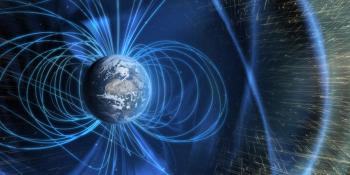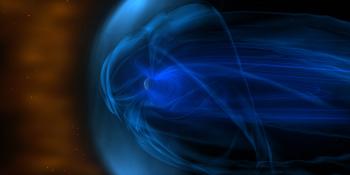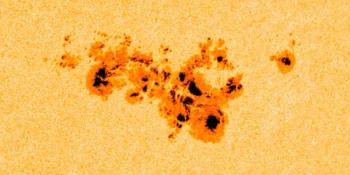Viewing archive of wtorek, 28 lutego 2012
Raport aktywności słonecznej
Any mentioned solar flare in this report has a scaling factor applied by the Space Weather Prediction Center (SWPC). Because of the SWPC scaling factor, solar flares are reported as 42% smaller than for the science quality data. The scaling factor has been removed from our archived solar flare data to reflect the true physical units.
Raport aktywności słoneczno- geomagnetycznej 2012 Feb 28 2200 UTCPrzygotowane przez NOAA © SWPC i przetworzone przez SpaceWeatherLive.com
Połączenie raportów USAF/NOAA o słonecznej i geofizycznej aktywności
Numer SDF 059 wydany w 2200Z na 28 Feb 2012IA. Analiza aktywności regionów słonecznych i aktywność od 27-2100Z do 28-2100Z Solar activity was very low during the past 24 hours.
IB. Prognoza aktywności słonecznej
Solar activity is expected to be very
low for the next three days (29 Feb - 02 Mar) with just a slight
chance for an isolated C-class flare.
IIA. Podsumowanie aktywności geofizycznej 27-2100Z do 28-2100Z
The geomagnetic field ranged from quiet to active levels with a
period of minor storm levels at some observatories during the local
nighttime hours. Quiet conditions prevailed from the beginning of
the period until about 07Z when a substorm interval began and
continued through about 09Z. The planetary activity reached active
levels but several individual stations attained minor storm levels
during the disturbance. Activity promptly returned to predominantly
quiet levels after the substorm and remained quiet for the rest of
the period. The disturbance was preceded by about two hours of
southward interplanetary magnetic field (IMF) seen at the ACE
spacecraft (0510-0702Z, with maximum southward deflection of -11
nT). The IMF was otherwise predominantly northwards during the
interval. ACE data also indicated a solar sector boundary crossing
at about 1534Z. The greater than 10 MeV protons observed by GOES
returned to background levels late on the 27th and remained there
through the end of the period.
IIB. Prognoza aktywności geofizycznej
The geomagnetic field is
expected to be quiet for the first two days (29 Feb - 01 Mar). A
slight increase to quiet to unsettled levels is expected on the
third day (02 Mar) due to a small but well positioned coronal hole.
III. Prawdopodobieństwa zdarzenia 29 Feb do 02 Mar
| Klasa M | 01% | 01% | 01% |
| Klasa X | 01% | 01% | 01% |
| Proton | 01% | 01% | 01% |
| PCAF | green | ||
IV. Przepływ 10,7 cm z Penticton
Zaobserwowano 28 Feb 103 Przewidywane 29 Feb-02 Mar 105/105/105 Średnia z 90 dni 28 Feb 128
V. Indeks geomagnetyczny A
Zaobserwowano Afr/Ap 27 Feb 012/019 Szacowane Afr/Ap 28 Feb 008/009 Przewidywane Afr/Ap 29 Feb-02 Mar 006/005-006/005-007/008
VI. Prawdopodobieństwa aktywności geomagnetycznej 29 Feb do 02 Mar
| A. Średnie szerokości geograficzne | |||
|---|---|---|---|
| Aktywne | 05% | 05% | 10% |
| Słaba burza | 01% | 01% | 01% |
| Bardzo znacząca burza | 01% | 01% | 01% |
| B. Wysokie szerokości geograficzne | |||
|---|---|---|---|
| Aktywne | 15% | 15% | 15% |
| Słaba burza | 10% | 10% | 25% |
| Bardzo znacząca burza | 05% | 05% | 15% |
<< Idź do codziennego przeglądu
Najnowsze wiadomości
Najnowsze wiadomości z forum
Geomagnetic storming, CMEs from AR 13664, 2024-05-09/10 718Is there any truth to this "Internet/Electrical Grid Apocalypse"? 123Weakening of Earths magnetic field due to geomagnetic excursion 21AR3664 718Is the DST index been updated ? 3
Więcej tematówWesprzyj SpaceWeatherLive.com!
Wielu ludzi odwiedza SpaceWeatherLive aby śledzić aktywność słoneczną lub sprawdzić czy jest szansa na zaobserwowanie zorzy polarnej. Niestety, większy ruch na stronie oznacza większe koszty utrzymania serwera. Dlatego, jeśli jesteś zadowolony ze strony SpaceWeatherLive, zachęcamy do wspierania nas finansowo. Dzięki temu będziemy mogli utrzymać naszą stronę.

Fakty na temat pogody kosmicznej
| Ostatnie rozbłyski klasy X | 2024/05/10 | X3.8 |
| Ostatnie rozbłyski klasy M | 2024/05/10 | M1.9 |
| Ostatnia burza geomagnetyczna | 2024/05/06 | Kp5 (G1) |
| Spotless days | |
|---|---|
| Ostatni dzień bez skazy | 2022/06/08 |
| Monthly mean Sunspot Number | |
|---|---|
| kwietnia 2024 | 136.5 +31.6 |
| maja 2024 | 138 +1.5 |
| Last 30 days | 167.9 +77.8 |


